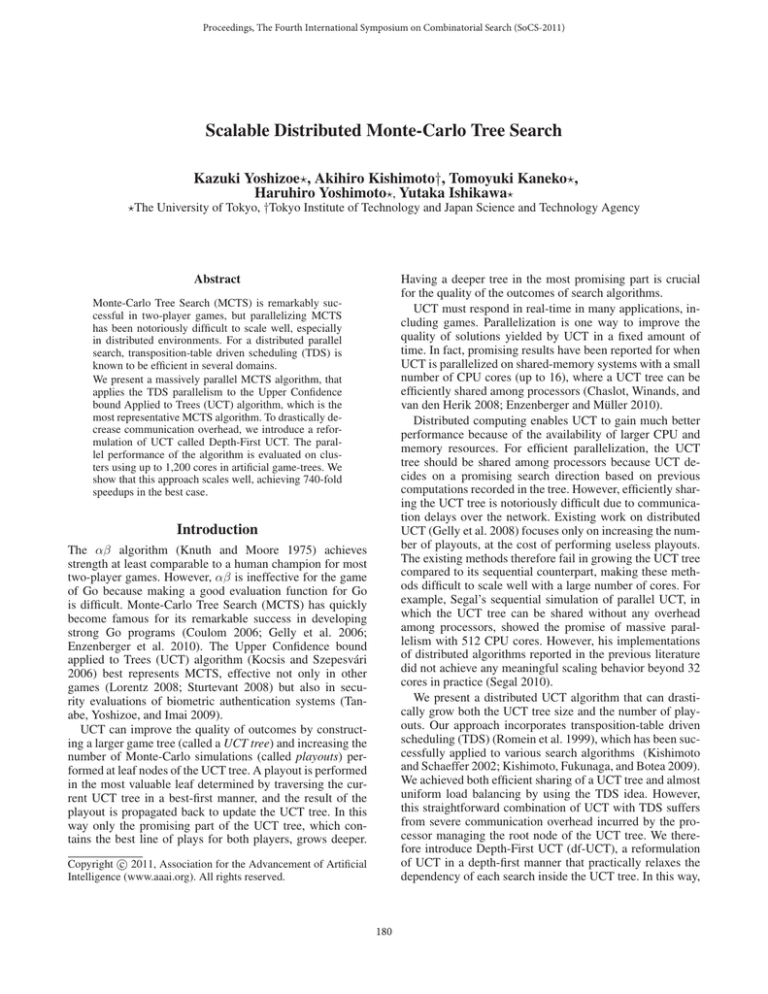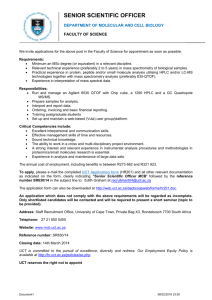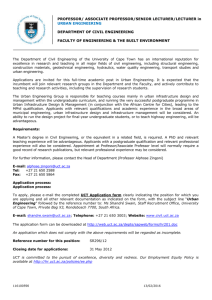
Proceedings, The Fourth International Symposium on Combinatorial Search (SoCS-2011)
Scalable Distributed Monte-Carlo Tree Search
Kazuki Yoshizoe, Akihiro Kishimoto†, Tomoyuki Kaneko,
Haruhiro Yoshimoto, Yutaka Ishikawa
The University of Tokyo, †Tokyo Institute of Technology and Japan Science and Technology Agency
Having a deeper tree in the most promising part is crucial
for the quality of the outcomes of search algorithms.
UCT must respond in real-time in many applications, including games. Parallelization is one way to improve the
quality of solutions yielded by UCT in a fixed amount of
time. In fact, promising results have been reported for when
UCT is parallelized on shared-memory systems with a small
number of CPU cores (up to 16), where a UCT tree can be
efficiently shared among processors (Chaslot, Winands, and
van den Herik 2008; Enzenberger and Müller 2010).
Distributed computing enables UCT to gain much better
performance because of the availability of larger CPU and
memory resources. For efficient parallelization, the UCT
tree should be shared among processors because UCT decides on a promising search direction based on previous
computations recorded in the tree. However, efficiently sharing the UCT tree is notoriously difficult due to communication delays over the network. Existing work on distributed
UCT (Gelly et al. 2008) focuses only on increasing the number of playouts, at the cost of performing useless playouts.
The existing methods therefore fail in growing the UCT tree
compared to its sequential counterpart, making these methods difficult to scale well with a large number of cores. For
example, Segal’s sequential simulation of parallel UCT, in
which the UCT tree can be shared without any overhead
among processors, showed the promise of massive parallelism with 512 CPU cores. However, his implementations
of distributed algorithms reported in the previous literature
did not achieve any meaningful scaling behavior beyond 32
cores in practice (Segal 2010).
We present a distributed UCT algorithm that can drastically grow both the UCT tree size and the number of playouts. Our approach incorporates transposition-table driven
scheduling (TDS) (Romein et al. 1999), which has been successfully applied to various search algorithms (Kishimoto
and Schaeffer 2002; Kishimoto, Fukunaga, and Botea 2009).
We achieved both efficient sharing of a UCT tree and almost
uniform load balancing by using the TDS idea. However,
this straightforward combination of UCT with TDS suffers
from severe communication overhead incurred by the processor managing the root node of the UCT tree. We therefore introduce Depth-First UCT (df-UCT), a reformulation
of UCT in a depth-first manner that practically relaxes the
dependency of each search inside the UCT tree. In this way,
Abstract
Monte-Carlo Tree Search (MCTS) is remarkably successful in two-player games, but parallelizing MCTS
has been notoriously difficult to scale well, especially
in distributed environments. For a distributed parallel
search, transposition-table driven scheduling (TDS) is
known to be efficient in several domains.
We present a massively parallel MCTS algorithm, that
applies the TDS parallelism to the Upper Confidence
bound Applied to Trees (UCT) algorithm, which is the
most representative MCTS algorithm. To drastically decrease communication overhead, we introduce a reformulation of UCT called Depth-First UCT. The parallel performance of the algorithm is evaluated on clusters using up to 1,200 cores in artificial game-trees. We
show that this approach scales well, achieving 740-fold
speedups in the best case.
Introduction
The αβ algorithm (Knuth and Moore 1975) achieves
strength at least comparable to a human champion for most
two-player games. However, αβ is ineffective for the game
of Go because making a good evaluation function for Go
is difficult. Monte-Carlo Tree Search (MCTS) has quickly
become famous for its remarkable success in developing
strong Go programs (Coulom 2006; Gelly et al. 2006;
Enzenberger et al. 2010). The Upper Confidence bound
applied to Trees (UCT) algorithm (Kocsis and Szepesvári
2006) best represents MCTS, effective not only in other
games (Lorentz 2008; Sturtevant 2008) but also in security evaluations of biometric authentication systems (Tanabe, Yoshizoe, and Imai 2009).
UCT can improve the quality of outcomes by constructing a larger game tree (called a UCT tree) and increasing the
number of Monte-Carlo simulations (called playouts) performed at leaf nodes of the UCT tree. A playout is performed
in the most valuable leaf determined by traversing the current UCT tree in a best-first manner, and the result of the
playout is propagated back to update the UCT tree. In this
way only the promising part of the UCT tree, which contains the best line of plays for both players, grows deeper.
c 2011, Association for the Advancement of Artificial
Copyright Intelligence (www.aaai.org). All rights reserved.
180
our distributed df-UCT synthesized with TDS can drastically reduce the communication overhead compared to the
version combining UCT with TDS.
The performance of our distributed algorithms was evaluated for up to 1,200 CPU cores in artificial game trees, a
representative domain used to investigate the performance
of game-tree search algorithms. Our results show that the
depth-first reformulation enables our distributed df-UCT to
scale very well, while a naive combination of UCT and TDS
has limited scalability.
achieve parallelism, CPUs must start a search before knowing the results of the latest search. If all the CPUs wait for the
latest results, no place could be executed in parallel. Therefore, note that any parallel MCTS may return different outcomes to the sequential version. Parallelizing MCTS is still
important because its performance is improved in practice.
In shared-memory environments, MCTS is effectively
parallelized with small modifications to the sequential version. Tree parallelization is the most promising approach
incorporated into many computer Go programs (Chaslot,
Winands, and van den Herik 2008; Enzenberger and Müller
2010; Gelly et al. 2006). Each processor independently traverses a shared tree in parallel to find a leaf node to perform
a playout. On the basis of the playout result, the statistical information stored in the tree is updated. Lock-free structures
have been used (Enzenberger and Müller 2010) to reduce
the overhead of mutex locks, which is usually unavoidable
in tree search. We parallelize UCT on the basis of tree parallelization for distributed-memory environments because of
the popularity of this approach.
Coulom’s virtual loss is crucial for making processors traverse different but promising parts of the tree in tree parallelization (Chaslot, Winands, and van den Herik 2008). A
processor selecting a branch to trace down to find a leaf pessimistically decreases the upper confidence bounds (UCB)
value of the branch by assuming that one playout results
in a loss, thus encouraging other processors to select other
moves. The UCB value is corrected after the actual playout
result is propagated back.
In distributed-memory environments, efficient implementation of tree parallelization is a serious issue (Segal 2010;
Bourki et al. 2010). Processors do not share memory, so
one processor cannot access the trees managed by the others
without incurring communication overhead. The most successful approach so far uses tree parallelization where memory can be shared and periodically broadcasts only an “important” part of the local tree among machines where memory is distributed (Gelly et al. 2008). However, in the rest of
the tree, playout results are independently accumulated on
different machines and useless playouts are performed. This
approach also cannot share virtual losses efficiently, possibly resulting in limited scalability. Our approach, in contrast,
can efficiently share both a UCT tree and virtual losses over
distributed machines.
Other reported approaches include root parallelization
and leaf parallelization (Chaslot, Winands, and van den
Herik 2008). However, both these approaches cannot build
a larger search tree compared to sequential MCTS. In root
parallelization, the performance gain is less successful than
tree parallelization with an extensive analysis of up to 64
processors (Soejima, Kishimoto, and Watanabe 2010). The
performance improvement of leaf parallelization is less than
that of root parallelization (Cazenave and Jouandeau 2007).
Related Work
Monte-Carlo Tree Search and UCT
MCTS (Kocsis and Szepesvári 2006) has recently had notable success, especially for the game of Go, where αβ has
failed to perform well. MCTS has become the de facto standard technique for developing the strongest computer Go
programs (Coulom 2006; Gelly et al. 2006; Enzenberger et
al. 2010).
MCTS yields solutions by aggregating the results of
Monte-Carlo simulations, called playouts, performed at the
leaf nodes of a search tree. In a playout starting at a node
p, each player keeps playing one of the legal moves with
randomness 1 until reaching a terminal position where the
winner of the game is determined by the rules of the game.
The outcome of the playout at p is usually defined as the
value (win or loss) of that terminal position. For simplicity,
draws are ignored in this paper.
Better solutions tend to be obtained when more playouts
are performed at important leaf nodes, while the importance
of each branch itself must be estimated by playouts. UCT
handles such trade-offs with a simple formula (Auer, CesaBianchi, and Fischer 2002). It performs a playout at the most
valuable leaf, decided by traversing the current search tree in
a best-first manner, and updates the winning probabilities of
the branches in the current path with the result of the playout
(see next section for details). Thus, UCT gradually grows its
search tree where important branches tend to have deep subtrees.
UCT is guaranteed to converge to an optimal policy
with an infinite number of iterations (Kocsis and Szepesvári
2006). However, due to many enhancements adopted for
empirical strength (Gelly and Silver 2009; Coulom 2007;
Gelly et al. 2006), practitioners often accept the possibility
of breaking the assumptions of such a theoretical guarantee. A variety of enhancements are available, but plain UCT
with no enhancements was used in our reported experiments
for simplicity. Additionally, UCT does not always return the
same solution for an identical problem with different random seeds. In fact, this phenomenon is often observed in
UCT-based computer Go programs.
Parallel Monte-Carlo Tree Search
Many researchers have parallelized MCTS to improve the
quality of outcomes yielded in a fixed amount of time. To
Transposition-table Driven Scheduling
TDS (Romein et al. 1999) simultaneously addresses the issues of load balancing and sharing of the search results,
which are crucial in many state-of-the-art algorithms including iterative deepening A* (IDA*) (Korf 1985). Romein
1
Certain moves are rarely considered as candidates for playouts.
For example, in Go, a move filling in an eye point is prohibited in
playouts because it is usually an extremely bad move.
181
et al.’s IDA* implementation utilizes a transposition table,
which is a large hash table that preserves results of previous
search efforts by mapping nodes to entries. Thus, information on nodes repeatedly visited can be reused by simply
retrieving it from the corresponding table entries.
In TDS, each processor manages a disjoint subset of the
transposition table entries. A hash function maps each table
entry exactly to one processor. That is, one large transposition table can be seen as being divided among all the processors. This distribution indicates that the size of the table
scales well with the number of distributed machines by increasing the total amount of available memory.
Whenever searching a node n, TDS distributes the job
n to the processor that keeps the table entry of n so that
the processor receiving n can locally check the entry. Each
processor periodically checks if a new node has arrived.
TDS might suffer from performance degradation caused by
a large communication overhead, which can be intuitively
understood because generated nodes are almost always sent
to other processors. However, Romein et al. showed that this
is not a significant concern, because all communications are
asynchronous. Once a processor sends out a generated node,
it can immediately work on another task without waiting for
messages sent by other processors, thus overlapping communication and computation.
The hash function plays an important part in uniformly
distributing the work across processors. In two-player
games, the Zobrist function (Zobrist 1970) is commonly
used to achieve good load balancing.
Romein et al.’s IDA* implementation based on TDS
achieved almost linear or even super-linear speedups with
128 processors. The TDS idea was later applied to other domains such as αβ search (Kishimoto and Schaeffer 2002),
and optimal planning (Kishimoto, Fukunaga, and Botea
2009).
Figure 1: Leaf node selection and result propagation
the number of visits to a child i, t is the total number of visits to all children, and wi is the number of wins accumulated
from the results of playouts at child i and its descendants.
Move i with high winning ratio wsii must be selected to
have a higher chance to win a game (exploitation). However, move j with a lower winning ratio should be selected if
the winning ratio is inaccurate due to small sj (exploration).
The exploration is controlled
√ by the second term of the UCB
value. The constant c is 2 in theory, but it is usually adjusted in a domain-dependent way.
The behavior of UCT is illustrated in Fig. 1. Branches are
sorted such way that the left-most branch is the best. When
UCT finishes a playout at leaf a, it increments wi (if necessary) and si of all the branches located between the root
r and a (i.e., backed up a → c, c → f , and f → r). Then,
from the root node, UCT recursively follows downward the
branch with the highest UCB value until it reaches a leaf
node, where a new playout will be performed. A leaf is expanded when the number of visits reaches a preset threshold.
In our experiments, the threshold was set to 4, since typical
computer Go programs set it to larger than 1.
Finally, when it is time to play a move, the move with the
largest number of visits is typically selected in computer Go.
At first glance, selecting a move either with the largest UCB
value or with the highest winning probability seems to be
the best choice, but this selection is often unreliable if there
is a much smaller number of visits to the selected move.
To improve performance, it is essential to build a larger
tree by repeating the above steps and concentrating on performing playouts at more promising parts of the search
space. For games, performing more playouts contributes to
more accurate estimation of the winning ratios of nodes.
Sequential UCT and Depth-First UCT
This section briefly explains the sequential UCT algorithm
and then introduces our Depth-First UCT (df-UCT) algorithm that turns UCT into a depth-first search.
UCT
UCT is an anytime algorithm that performs as many iterations as possible until the time has come to play a move for
a given position. In each iteration, UCT performs a playout,
where a game is played out by selecting moves with randomness, as well as incrementally building a search tree in memory. UCT first traverses a tree starting from the root by selecting the most important move until it reaches a leaf node.
The importance of a move is evaluated according to its UCB
value, explained in the next paragraph. UCT then expands
that leaf if necessary and performs a playout there. Next, the
playout result is propagated along the path back from the
leaf to the root and the UCB values of all the branches on
the path are updated.
The UCB value of a branch
i (i.e., a move in games) is deln t
wi
+c
where c is a constant, si is
fined as UCB(i) =
si
si
Depth-First UCT
A best-first search can often be turned into a depth-first
search to preserve the merits of both approaches. Our dfUCT algorithm reformulates UCT in a depth-first manner.
Df-UCT has the advantage of revisiting interior nodes less
frequently. This reduced revisiting contributes to drastically
reducing communication overhead in distributed environments for parallel df-UCT (see the following section and
experimental results).
The idea behind df-UCT is based on an observation that
once UCT finds a significantly promising part of the search
space, playouts are most frequently performed around that
part. However, UCT always propagates back a playout result to the root in each iteration to restart the procedure of
selecting a new leaf from the root (left of Fig. 1). Df-UCT, in
182
contrast, immediately traces down a tree at an interior node
n without propagating back the playout result to the root if
n is still on the most promising path. Thus, it explores the
most promising search space as long as possible, while it can
select the same leaf nodes chosen by UCT in most cases. On
the right of Fig. 1, the left-most branch in each level has a
larger UCB value than other sibling branches. When df-UCT
backtracks to c from a, it checks whether both UCB(r →
f ) ≥ UCB(r →g) and UCB(f →c) ≥ UCB(f →d) hold.
If both conditions still hold, df-UCT immediately moves to
b. Unlike UCT, df-UCT does not unnecessarily update the
UCB values on path c→f →r or trace down path r→f →c
again. Returning to r is delayed until r→g becomes the best.
Df-UCT manages a local stack as in the standard depthfirst search. Assume that df-UCT is currently at node n, and
let the best and second-best moves be mp and mq , respectively. When df-UCT moves to n’s child reached by mp , it
pushes to the local stack the numbers of wins for mp and
mq , the numbers of visits to mp and mq , and the number of
visits to n. They are used to check if df-UCT is required to
backtrack to an ancestor by recomputing the UCB values.
When a playout is finished at node x, df-UCT examines
its local stack. If UCB(mp ) < UCB(mq ) holds for any ancestor n of x that is saved in the local stack, df-UCT proves
that the most promising move is changed to mq from mp at
node n. Therefore, it must return to n to select mq by popping the appropriate information from the stack.
In our current implementation, moves that are inferior to
the second-best one are ignored and not saved in the local
stack. In theory, such inferior moves might become the best
after the UCB values are recomputed because of the second
term in UCB(i). In principle, if df-UCT’s local stack manages all the branches of nodes located on the current path,
this problem can be safely avoided at the cost of extra memory and computation overhead for managing the stack. However, such a scenario does not occur frequently in our experiments on artificial game trees. Investigating a trade-off in
practice (e.g., storing the second- and third-best moves to
further reduce such an error) is an important direction for
future work.
Figure 2: Distributed UCT combined with TDS
(called the home processor) and then move n there. The ID
of the home processor is generated by a simple calculation
using the hash key. Once n is sent there, its table entry can
be accessed locally with n’s hash key.
Unlike TDS, each processor in our distributed UCT creates search jobs and report jobs (Fig. 2). A search job is
created when the algorithm determines the best move at the
current node n and generates its child nc . A search job for nc
must be sent to nc ’s home processor. This step is recursively
applied until leaf node is found where a playout is performed
locally. A report job is created to propagate back a playout
result to update the UCB value. The home processor of nc
sends a report job to n’s home processor P . P receives the
result of the job, updates the UCB value with the result, and
sends another report job upward. This step is repeated until
the root receives the job and one iteration (in the sense of
sequential UCT) is completed.
The procedures of selecting a leaf and back-propagating
its playout result are represented as a recursive function in
sequential UCT. In our distributed UCT, each processor has
a job queue to manage search and report jobs. It (1) periodically checks if new jobs have arrived, (2) pushes a received
job to the queue, and (3) pops one job from the queue to do
an appropriate task (i.e., search or report). These procedures
are implemented as simple a while-loop (see TDS UCT in
Fig. 3). Our distributed UCT inherits all the advantages of
TDS, including asynchronous communication that enables
overlap of communication and computation, and almostuniform load balancing.
For all the processors to be busy, the number of jobs J
spawned at the root must be greater than the number of processors N . J is set to 20N in our implementation. Segal’s
sequential simulation of parallel UCT (Segal 2010) shows
the strength degradation for large J. We believe that our distributed UCT behaves similarly in theory, although the parallel overheads should be taken into account in practice.
Virtual losses are incorporated into our distributed UCT
because they play an important role in distributing search
jobs near the promising search spaces explored in sharedmemory parallel environments (Segal 2010). Due to the advantage of TDS, the virtual loss information of node n is
always available at n’s home processor. Thus, by accessing
n’s hash table entry only locally, our distributed UCT can
Distributed UCT
We first explain a distributed algorithm integrating TDS with
UCT and then replace UCT with df-UCT.
Distributed UCT Based on TDS
Our distributed UCT leverages TDS to efficiently share
a UCT tree among processors over the network. In other
words, UCT trees are partitioned over processors in a disjoint way and can be seen as one large UCT tree.
Our distributed UCT inherits the TDS strategy in which
the work must always be moved to the processor where its
corresponding data is located. In our implementation, each
disjoint subset of the entire UCT tree is preserved as a hash
table of each processor. The Zobrist hash function (Zobrist
1970) calculates the hash key of a node in the tree. When
generating a node n, our distributed UCT must find the
processor that has the corresponding hash table entry of n
183
DistributedUCT(tree node root, time allotted, int nparallel) {
start TDS UCT() in all processors
foreach (1..nparallel) {
nj = Job(Type:SEARCH, Node:root)
SendJob(HomeProcessor(root), nj)
}
while (elapsed() < allotted) {
if (ReceiveJob()!=null) {
nj = Job(Type:SEARCH, Node:root)
SendJob(HomeProcessor(root), nj)
}
}
stop all running jobs and gather all results to root node
}
TDS UCT () {
while (!Finished()) {
if ((job = ReceiveJob())!=null) EnqueueJob(job)
// received a job from another processor
if ((job = PopJobQueue())==null) continue
tree node n = job.Node
entry e = LookUpHashTable(n)
// statistics are stored in local memory
}
}
if (job.Type == SEARCH) {
if (e.t < threshold) {
player winner = doPlayout()
e.t+=1; WriteToHashTable(e)
nj = Job(Type:REPORT, Winner:winner, Node:n.parent, Child:n)
SendJob(HomeProcessor(n.parent), nj)
} else {
int i = find move id with the highest UCB value
e.t+=1; WriteToHashTable(e) // virtual loss
nj = Job(Type:SEARCH, Node:n.child[i])
SendJob(HomeProcessor(n.child[i]), nj)
}
}
else if (job.Type == REPORT) {
player winner = job.Winner
int i = n.indexOfChild(job.Child)
e.si += 1, e.wi += (n.turn == winner) ? 1 : 0
WriteToHashTable(e)
nj = Job(Type:REPORT, Winner:winner, Node:n.parent, Child:n)
SendJob(HomeProcessor(n.parent), nj)
}
Figure 3: Pseudo code of distributed UCT
tions N . Compared to distributed UCT, distributed df-UCT
greatly reduces the number of messages exchanged at the
home processor of the root with large N .
Unlike distributed UCT, explained in the last subsection,
the distributed df-UCT algorithm based on TDS must decide
whether to trace down the most promising child of node n
by spawning a search job for the child or to send a report
job to the home processor of n’s parent, when a report job
for n is received. Df-UCT makes this decision by checking its local stack. Therefore, when a search job is created,
distributed df-UCT must send the complete information on
the local stack as well. This additional information can increase the communication overhead. In our implementation,
the job packet size for naive distributed UCT was approximately 100 bytes, while it increased to 2 or 3 kilobytes for
distributed df-UCT. However, this is a small price to pay to
obtain drastic speedups (see the next section).
Several nodes are packed into one message to send
in (Romein et al. 1999), but this is not the case in TDSAB,
a parallel αβ search based on TDS (Kishimoto and Schaeffer 2002), due to the importance of preserving the search
order such that the most promising nodes must be expanded
as soon as possible. Our scenario is very similar to that of
TDSAB. Promising search jobs must be executed immediately, while the UCT tree must be updated to the latest
as quickly as possible. It is therefore difficult to leverage
Romein et al.’s technique.
One small modification specific to our distributed df-UCT
is that only the second-best move takes the virtual loss information into account when each processor recomputes the
UCB values of the best and second-best moves saved in the
local stack of df-UCT. This technique slightly decreased the
number of report jobs.
obtain the exact number of processors currently marking the
virtual losses.
Assume that the number of search jobs descending from
child i is di . The original UCB
value definition is modified as follows, where dT = j∈i ssiblings dj . Considering
virtual loss, UCB(i) decreases as more processors select i,
which makes other processors prefer other variations.
ln(t + dT )
wi
+c
(1)
UCB(i) =
s i + di
s i + di
Distributed Depth-First UCT
One drawback of combining UCT with TDS is the excessive
amount of communication, especially to the home processor
of the root. This issue becomes more serious for a larger
number of processors. For example, assume that the average
search depth of the UCT tree is d in N iterations, and that
search and report jobs must always be sent to another processor whenever they are created. This assumption is reasonable for massive parallelism, since the probability of the
TDS strategy assigning node n’s child to n’s home processor
is low with a large number of processors. The total number
of messages received by all the processors is approximately
2dN . Moreover, since each iteration always starts at the root,
the home processor of the root must send or receive at least
N jobs. When N becomes large (6–20 million in our experiments), the number of messages exchanged is very unbalanced among processors.
Df-UCT overcomes this problem by reducing the frequency of propagating back a playout result. On average, dfUCT has a shorter path traced back to update the UCB value
than UCT. Additionally, the frequency of df-UCT backtracking to the root is much smaller than the number of itera-
184
Experimental Results
Table 1: Sequential search execution time (seconds)
Setup of Experiments
To show the scalability of our distributed algorithms, experiments were conducted on artificial game trees called Pgame (Smith and Nau 1994). We prepared three algorithms:
(1) U CT 1: UCT + TDS, (2) U CT 2: a version of U CT 1 modified by assigning one special processor working only on exchanging messages on the root node, and (3) DF U CT: DfUCT + TDS. For a P-game tree, we use virtual playouts that
merely wait without doing anything for a certain time period. We tested two kinds of playout granularity (0.1 and 1.0
millisecond (ms)), corresponding to those performed by typical Go programs with the board sizes of 9 × 9 and 19 × 19,
respectively. We measured the elapsed time required until
each version finished performing a fixed number of playouts
per problem (20 million for the 0.1-ms playout and 6 million
for the 1-ms playout). Since DF U CT does not always return
to the root due to its depth-first reformulation, it does not
have the latest information on the total number of playouts
performed by all the processors. We therefore ran DF U CT
until each processor performed at least 1.05 × K
N playouts, where K is the number of playouts and N is the number of processors. This resulted in DF U CT performing more
playouts than the other two versions, which slightly underperforms the expected speedup value of DF U CT2 .
We tested three cases of uniform branching factors (8, 40,
and 150). The branching factors of 40 and 150 are similar to
the average branching factors in Go with the board sizes of
9 × 9 and 19 × 19, respectively. We tested two playout granularities for each branching factor, resulting in a total of six
categories. Ten problems were generated, and the runtime
was averaged over all problems in each category.
All experiments were run on a cluster of machines where
each compute node was interconnected by QDR Infiniband
x 2 (80 Gbps) and had two hexa core Xeon X5670 processors at 2.93 GHz (12 CPU cores) with 54 GiB memory. We
used at most 100 compute nodes. All the algorithms were
parallelized using an implementation of the Message Passing Interface library. When N CPU cores were used, N MPI
processes were invoked and communicated by MPI operations even if they were running on the same compute node.
Br. factor
DF U CT
U CT
0.1-ms playout
8
40
150
2,108 2,129 2,243
2,303 2,365 2,847
1.0-ms playout
8
40
150
6,027 6,034 6,068
6,068 6,074 6,200
elapsed time, a playout at node N returned either 1 or 0 with
a probability defined by the score of N via sigmoid function
1/(1 + e−score(N )/128 ). The probability of the playout result
of 1 becomes higher for high scores.
Sequential Search Performance
We compared the performances of sequential U CT and
DF U CT , since the best sequential algorithm must be chosen as a baseline when measuring speedups of parallel algorithms. Table 1 shows the execution time, which includes
the time for playout execution and for other operations such
as management of a UCT tree. Both U CT and DF U CT spent
the same amount of time in playout execution: 2,000 s for
the 0.1-ms playouts and 6,000 s for the 1.0-ms playouts.
As the table shows, DF U CT was faster than U CT in all
the categories. The performance difference increased with
a larger branching factor and faster playout speed. For example, when the playout time was set to 0.1 ms, 15–40 %
of the execution time spent by U CT was related to managing
the U CT tree, such as its hash table accesses and traversing the tree. Due to its unnecessary backtracking, U CT was
slower than DF U CT by 22% in the worst case.
As explained previously, DF U CT occasionally performs
a playout at a different leaf than U CT. Such cases occur
when a move with the UCB value that is smaller than the
second-best one becomes the best move after a playout. Table 2 shows that only 1–2 % of the U CT backups were such
a case.
To check whether the above difference in behavior between DF U CT and U CT is acceptable, we evaluated the
strengths of these algorithms by holding 400-game matches
for branching factors of 8, 40, and 150. Each 400-game
match was played as follows. First, 20 P-game trees were
prepared with limited depths. For branching factors of 8, 40,
and 150, the depths were limited to 30, 20, and 10, respectively. On each P-game tree, DF U CT played games against
U CT with ten different seeds and with either player moving
first. This resulted in a total of 40 games on each tree.
The results with 100,000 playouts are shown in Table 3.
DF U CT was very slightly stronger than U CT with the same
number of playouts. Additionally, since DF U CT was faster
than U CT, it could perform more playouts than U CT in a
fixed amount of time. Hence, DF U CT’s modified move selection did not hurt its playing strength compared to U CT.
Artificial Game Tree
P-game models two-player games and is commonly used to
evaluate search algorithms (Kocsis and Szepesvári 2006). A
random value is assigned to each branch of P-game’s tree,
and the score of a node is defined as the sum of the branch
values in the path from the root to that node. In our implementation, a uniform distribution was used to compute
each branch value range of [−255, 0] for the first player and
[0, 255] for the second. For all nodes, the value of 0 was
assigned to one branch to set the true min-max value of the
tree to 0. In P-game, more promising moves tend to be available for a player once that player gains the advantage, as occurs in actual games. In our implementation, after a specified
Distributed Search Performance
Table 4 gives observed speedups for up to 1,200 cores compared to sequential DF U CT, which is a better baseline than
U CT as we discussed in the previous subsection. The average speedup for ten problems is shown. Our distributed
2
This is not a serious issue because UCT will be controlled by
the time limits rather than the number of total playouts in practical
situations such as real tournament games.
185
Table 4: Average speedup (best cases in bold)
Table 2: Frequency of third-best or less-promising move becoming best after a playout
#playouts
6 million
20 million
Br. 8
1.27%
0.995%
Br. 40
2.33%
1.78%
Br. 150
1.98%
1.74%
Table 3: P-game strength: UCT vs. df-UCT (Wins and
Losses are for the first player)
Br.
8
8
40
40
150
150
Dp.
30
30
20
20
10
10
1st player
UCT
df-UCT
UCT
df-UCT
UCT
df-UCT
2nd player
df-UCT
UCT
df-UCT
UCT
df-UCT
UCT
Win
80
84
157
159
58
65
Loss
119
116
39
36
140
130
Draw
1
0
4
5
2
5
DF U CT not only scaled well, but its observed speedups were
significantly larger than the two versions based on UCT +
TDS, especially with a large number of cores. For example,
with a branching factor of 8 and the playout time of 1 ms,
DF U CT achieved a 741-fold speedup on 1,200 cores, while
U CT 1 and U CT 2 were limited to at most 70-fold speedups.
U CT 1 and U CT 2 modestly scaled up to a limit of around 36
cores with the 1-ms playout. However, the performance improvements with additional cores became much smaller than
that of DF U CT. Additionally, compared to U CT 1, U CT 2 did
not have noticeably improved speedup, indicating that an ad
hoc modification reducing the communication overhead at
the root is not sufficient and the depth-first reformulation
technique incorporated into DF U CT is essential to achieve
scalability.
It became significantly more difficult to achieve good
speedups with a shorter playout time (0.1 ms). This is not
surprising because a longer playout time can hide the overheads incurred by distributed tree search, such as communication and managing the job queue. However, DF U CT still
yielded over 250-fold speedup in all cases, while U CT 1 and
U CT 2 were limited to around 10-fold speedup each.
Table 5 shows the maximum and average numbers of report jobs (max node and avg., respectively) and the number of report jobs received per playout (RP/pl). The differences between the maximum and average in DF U CT were
small, while they were extremely large in both U CT 1 and
U CT 2. The report jobs were almost uniformly distributed in
DF U CT , while they were concentrated on a specific processor, (the one in charge of the root for most cases) for U CT 1
and U CT 2. In U CT 1 and U CT 2, one processor that was not
the home processor of the root received over 21 million report jobs with the branching factor of 8 because it was home
to several nodes that spawned search jobs very frequently.
The RP/pl field indicates that both U CT 1 and U CT 2 propagated a playout result all the way back to an ancestor node
about 20 levels up in the tree, while DF U CT propagated back
2–3 levels. Using DF U CT greatly reduced the number of report jobs.
Our current implementation specific to DF U CT sends out
Cores
12
36
72
144
300
600
1200
Branching factor 8
0.1-ms playout
1.0-ms playout
U CT 1 U CT 2 DF U CT U CT 1
U CT 2
DF U CT
3.29
3.13
8.68
7.26
6.92
10.0
5.15
5.50
25.6
18.7
19.0
30.1
5.78
6.39
45.1
27.1
27.8
59.5
5.96
6.44
84.4
36.8
37.6
120.7
6.78
7.36
123.7
47.0
51.3
250.4
9.88
9.13
258.7
62.2
62.9
473.1
9.93
9.95
327.8
67.7
69.5
741.2
Cores
12
36
72
144
300
600
1200
Branching factor 40
0.1-ms playout
1.0-ms playout
U CT 1 U CT 2 DF U CT U CT 1
U CT 2
DF U CT
5.33
5.26
9.20
9.11
8.75
10.3
8.08
8.77
26.3
23.7
24.6
29.1
8.18
8.61
50.7
35.9
38.8
58.7
8.88
9.26
89.9
50.9
57.1
114.2
9.30
9.89
140.5
68.4
78.2
229.4
11.2
11.8
236.8
80.4
98.4
442.4
11.5
12.1
257.6
89.2
102.2
635.6
Cores
12
36
72
144
300
600
1200
Branching factor 150
0.1-ms playout
1.0-ms playout
U CT 1 U CT 2 DF U CT U CT 1
U CT 2
DF U CT
4.74
5.46
9.33
9.01
8.71
10.3
7.31
7.64
25.1
21.6
22.3
29.7
7.29
7.49
46.1
30.8
33.3
52.2
7.29
7.53
87.0
38.5
44.2
110.8
7.35
7.45
147.7
45.0
48.5
210.7
8.39
8.29
239.3
51.4
57.7
416.0
9.08
8.93
251.6
64.4
65.7
600.8
messages to all cores to force all jobs to return to the root
at the end of the search. A considerable amount of time was
required when a large number of cores was involved (e.g.,
1–3 s, which was approximately 10-30% of the execution
time with 1,200 cores). This overhead can be ignored with
longer time settings. Table 6 presents speedups without such
overhead that reached nearly 1,000-fold using 1,200 CPU
cores, showing the potential of DF U CT.
Conclusions and Future Work
We parallelized UCT in a distributed environment. When
UCT was combined with TDS in a straightforward way, we
obtained discouraging results in artificial game trees due to
the large communication overhead centralized on a specific
processor. However, by combining Depth-First UCT with
TDS, we achieved drastic improvements. The speedup obtained by our distributed DF U CT was over 700-fold with
1,200 CPU cores in the best case. This is encouraging, since
achieving reasonable scalability for parallel MCTS is notoriously challenging.
One important direction for future work is to investigate the performance of our distributed DF U CT in actual
games. We are currently implementing it on top of one of
186
Table 5: Number of received report jobs for 20 million playouts (0.1-ms playout, 600 cores)
U CT 1
U CT 2
DF U CT
Max node
21,712,516
21,802,853
100,738
Branch 8
Avg.
685,065
697,210
82,016
RP/pl
20.6
20.9
2.64
Branch 40
Max node
Avg.
20,398,836 242,752
20,000,000 240,174
118,725
66,895
0.1-ms playout
Br.8
Br.40
Br.150
8.69
9.20
9.34
25.6
26.3
25.2
45.2
50.8
46.2
84.7
90.1
87.2
126.2
143.1
149.0
277.2
264.5
266.5
445.3
393.6
364.1
Branch 150
Max node
Avg.
20,054,697 183,474
20,000,000 186,873
158,115
58,039
RP/pl
5.50
5.61
1.74
IEEE Trans. on Computational Intelligence and AI in Games
2(4):259–270.
Gelly, S., and Silver, D. 2009. Combining online and offline knowledge in UCT. In the 24th International Conf. on
Machine Learning, 273–280.
Gelly, S.; Wang, Y.; Munos, R.; and Teytaud, O. 2006. Modification of UCT with patterns in Monte-Carlo Go. Technical
Report 6062, INRIA.
Gelly, S.; Hoock, J. B.; Rimmel, A.; Teytaud, O.; and
Kalemkarian, Y. 2008. The parallelization of Monte-Carlo
planning. In Proc. 5th International Conf. on Informatics in
Control, Automation, and Robotics, 198–203.
Kishimoto, A., and Schaeffer, J. 2002. Distributed game-tree
search using transposition table driven work scheduling. In
Proc. 31st Inter. Conf. on Parallel Processing, 323–330.
Kishimoto, A.; Fukunaga, A.; and Botea, A. 2009. Scalable,
parallel best-first search for optimal sequential planning. In
Proc. ICAPS-2009, 201–208.
Knuth, D. E., and Moore, R. W. 1975. An analysis of alpha–
beta pruning. Artificial Intell. 6(4):293–326.
Kocsis, L., and Szepesvári, C. 2006. Bandit based MonteCarlo planning. In 17th European Conf. on Machine Learning (ECML 2006), 282–293.
Korf, R. E. 1985. Depth-first iterative-deepening: An optimal admissible tree search. Artificial Intell. 27(1):97–109.
Lorentz, R. 2008. Amazons discover Monte-Carlo. In Proc.
Computers and Games (CG’2008), 13–24.
Romein, J. W.; Plaat, A.; Bal, H. E.; and Schaeffer, J. 1999.
Transposition table driven work scheduling in distributed
search. In Proc. AAAI’99, 725–731.
Segal, R. 2010. On the scalability of parallel UCT. In Proc.
Computers and Games (CG’2010).
Smith, S., and Nau, D. 1994. An analysis of forward pruning. In 12th National Conf. on Artificial Intell., 1386–1391.
Soejima, Y.; Kishimoto, A.; and Watanabe, O. 2010. Evaluating root parallelization in Go. IEEE Trans. on Computational Intelligence and AI in Games 2(4):278–287.
Sturtevant, N. R. 2008. An analysis of uct in multi-player
games. In Proc. Computers and Games (CG’2008), 37–49.
Tanabe, Y.; Yoshizoe, K.; and Imai, H. 2009. A study on
security evaluation methodology for image based biometrics
authentication systems. In IEEE 3rd International Conf. on
Biometrics: Theory, Applications and Systems (BTAS09).
Zobrist, A. 1970. A new hashing method with applications
for game playing. Technical report, Department of Computer Science, University of Wisconsin.
Table 6: Speedup values obtained by excluding time that distributed df-UCT spent in forcing all jobs to return to root at
end of parallel search
Cores
12
36
72
144
300
600
1,200
RP/pl
7.28
7.21
2.01
1.0-ms playout
Br.8
Br.40 Br.150
10.0
10.3
10.4
30.2
29.2
29.7
59.6
58.8
52.2
120.8 114.4 111.0
252.2 234.9 216.5
510.7 485.4 450.8
997.1 920.9 839.4
the strongest Go programs. There are numerous obstacles
to improving the playing strength of computer Go based on
distributed df-UCT, such as non-uniform branching factors,
varied playout granularity, and enhancements added to sequential UCT. Ideas to overcome them are topics of current
research.
References
Auer, P.; Cesa-Bianchi, N.; and Fischer, P. 2002. Finitetime analysis of the multi-armed bandit problem. Machine
Learning 47:235–256.
Bourki, A.; Chaslot, G.; Coulm, M.; Danjean, V.; Doghmen,
H.; Hoock, J.-B.; Hérault, T.; Rimmel, A.; Teytaud, F.; Teytaud, O.; Vayssière, P.; and Yu, Z. 2010. Scalability and
parallelization of Monte-Carlo tree search. In Proc. Computers and Games (CG’2010).
Cazenave, T., and Jouandeau, N. 2007. On the parallelization of UCT. In the Computer Games Workshop, 93–101.
Chaslot, G. M. J.-B.; Winands, M. H. M.; and van den Herik,
H. J. 2008. Parallel Monte-Carlo tree search. In Proc. Computers and Games (CG’2008), 60–71.
Coulom, R. 2006. Efficient selectivity and backup operators
in Monte-Carlo tree search. In Proc. 5th International Conf.
on Computer and Games, 72–83.
Coulom, R. 2007. Computing elo ratings of move patterns
in the game of Go. In Computer Games Workshop 2007.
Enzenberger, M., and Müller, M. 2010. A lock-free multithreaded Monte-Carlo tree search algorithm. In Advances in
Computer Games 12 (ACG’2009), 14–20.
Enzenberger, M.; Müller, M.; Arneson, B.; and Segal, R.
2010. FUEGO - an open-source framework for board
games and Go engine based on Monte-Carlo tree search.
187









